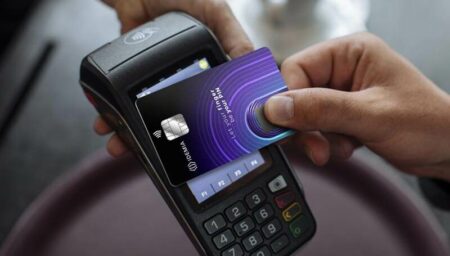Let your finger be your PIN with F.CODE

An explosion in payment card issuance is behind a global initiative to extend the standardized payment card numbering system so that more payment cards can be issued.
When the world’s first payment cards launched1 in New York in 1950, virtually all global in-store payments were made with cash. The payment card has proven to be an enormous success—more than 70 years later, 50% of the world’s in-store payments are made with payment cards2. Payment card usage continues to grow and has received a significant boost from customers switching to, or increasing their usage of, contactless payment cards during the pandemic. Customers like using payment cards as they are widely accepted by merchants and simple to use.
As banks increasingly reduce their branch networks and physical touch points, the payment card is becoming the most tangible link between a bank and its customers. This is one of the factors driving proliferation of increasingly innovative payment card designs to reinforce the bank brand and strengthen customer loyalty. An interesting recent development is the growing number of new payment card issuers—from neobanks to mobile wallets to fintechs—that are now launching physical payment cards in addition to their digital payments services. These new entrants have realized that payment cards are an excellent marketing tool that replay the promotional and branding experience every time a customer takes out their payment card. Apple, Google, Samsung, Amazon, Grab, Venmo, Uber and others, are not only launching payment cards but creating waves with ground-breaking card designs, often with innovative materials.
Payment card issuance in different formats is growing at a rapid pace and driven by innovations such as:
This growth has put pressure on the industry to ensure availability of Bank Identification Numbers (BINs) which comprise the first digits of the Primary Account Number (PAN) and facilitate financial institution identification to stakeholders within the payment ecosystem. BINs are foundational to the payment card business and are governed by the International Organization for Standardization (ISO).
To determine the best path forward, ISO convened payment industry stakeholders from around the world. After much discussion, they agreed to extend the length of the issuing BIN from six to eight digits. ISO announced the new standard in 2017. ISO is already assigning 8-digit BINs for new requests, and each payment brand is responsible for setting their own approach to comply with the new industry standard.
Visa endorsed the standard in 2017 and announced April 2022 as its final effective date. JCB as well as other payment schemes are working towards the same timeline. Effective April 2022, the payment ecosystem must be ready to support the new 8-digit BIN industry standard. All stakeholders including acquirers, merchants, processors, and their service providers need to work together to make necessary changes. On the issuing side, issuers can set their own timeline to convert existing 6-digit BINs and will receive newly requested issuing BINs as 8-digit BINs after April 2022. The importance of stakeholder readiness cannot be overstated—it is critical for the success of payment transaction processes and to prevent service disruptions that stakeholders are ready and prepared to support this change. Stakeholders that are not ready for the new standard may experience a number of impacts including, but not limited to, transaction processing, issuing product management, cardholder servicing, ATM, merchant servicing and disputes, fraud management, loyalty and benefits program management, reporting, billing, and other back-end systems.
All payment card industry stakeholders are strongly encouraged to take action now by carrying out an impact assessment to identify how they might be using 6-digit BINs in their systems and what changes need to happen before April 2022. Given Issuers have discretion to expand any or all of their BINs to 8-digits, and to set their own timeline for the expansion, 6-digit BINs may coexist. The changes required to accommodate 8-digit BINs may necessitate extended timelines. It is critical that this project is scheduled and prioritized now to ensure readiness by April 2022. Visa and JCB will continue to regularly communicate with payment industry stakeholders regarding migration to the 8-digit BIN. Refer to the Numerics Initiative on visa.com to learn more about potential impacts of the 8-digit BIN and what you should be doing now to prepare.
All stakeholders in the payment card ecosystem need to be aware of this change and take necessary action to support and prepare for 8-digit BINs. Customers will continue to be offered new and innovative payment cards, both physical and virtual. The pandemic-driven focus on “touchless” will accelerate issuance of biometric contactless payment cards. Growth in online commerce will increase the attraction of dynamic CVV/CVC display cards. An increasing number of crypto cards will enable customers to spend their cryptocurrencies in the real world at millions of global payment card acceptance points. All of these cards and their tokenized and digital versions will need to shift to 8-digit BINs. Make sure that your organization is prepared for the transition!
1 – https://www.experian.com/blogs/ask-experian/the-history-of-credit-cards/
2 – https://worldpay.globalpaymentsreport.com/en/